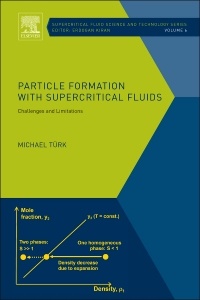Description
Particle Formation with Supercritical Fluids
Challenges and Limitations
Supercritical Fluid Science and Technology Series
Author: Turk Michael
Language: English
Subjects for Particle Formation with Supercritical Fluids:
Keywords
Chemical transformation; complex mixtures; Equation of State; Future trends; Gas antisolvent; Gas-saturated liquid phase; inorganic and metallic nanoparticles; low-volatile compounds; Modeling particle formation and growth; Nucleation; particle formation and growth; particle formation processes; pharmaceuticals; Phase behavior; phase separation; polymers; Rapid expansion of supercritical solutions; research needs; Supercritical fluids
152 p. · 15x22.8 cm · Hardback
Description
/li>Contents
/li>Readership
/li>Biography
/li>Comment
/li>
The introduction to high pressure and high temperature phase equilibria and nucleation phenomena provides the basic principles of the underlying physical and chemical phenomena, allowing the reader an understanding of the relationship between process conditions and particle characteristics.
Bridging the gap between theory and application, the book imparts the scientific and engineering fundamentals for innovative particle formation processes. The interdisciplinary "modus operandi" will encourage cooperation between scientists and researchers from different but complementary disciplines.
His current research activities are focused on the use of supercritical fluids (mainly CO2 and H2O) as media to prepare organic, inorganic and metallic materials by physical transformation or chemical reaction and the development of new, energy-efficient and environmentally-friendly strategies to create novel products with extraordinary performance for pharmaceutical, energy and biomedical applications.
So far, M. Türk has authored 125 articles (including 13 book chapters); has graduated 20 PhD students (10 as supervisor and 10 as co-advisor) and more than 50 Diploma / Master and 15 Bachelor students.
- Focuses on the general principles of particle formation in supercritical fluids
- Considers high pressure and high temperature phase equilibria, fluid dynamics and nucleation theory
- Discusses the underlying physical and chemical phenomena needed to understand the different applications, pointing out the relationship between process conditions and product properties




